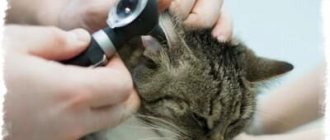Contrary to popular belief, cats do not have nine lives. And they don't always land on their feet. In fact, they are much more vulnerable than you think.
In addition, they may suffer from a variety of health problems similar to those experienced by humans. One such problem is front leg lameness.
As kittens age, they weaken and their general health deteriorates. Besides the obvious condition of your cat's skin and coat, one of the most common signs of aging hairballs in cats is lameness.
My cat is limping, is it serious?
It is difficult to answer this question accurately without examining the cat and observing the development of the symptom. Lameness varies in its amplitude and in its origin. As a general rule, the more a cat limps on a front leg, the more severe the lameness. However, severe lameness is often easier to treat, such as lameness associated with a fracture. Conversely, milder lameness is more difficult to correct.
© shutterstock
Degrees_ that a paw bruise can take in a kitten or an adult cat
Mechanical damage to the limb such as a bruised paw in cats is divided into four degrees:
11th degree. A characteristic feature of bruises is damage to the inner layers of the skin and subcutaneous tissue. A bruise may be accompanied by the formation of a shallow wound such as an abrasion or scratch. Swelling of the injury site and pain are likely. The pain is mild and may be completely absent. Upon examination, you can notice signs of burst blood vessels on the surface of the animal’s skin. A first degree bruise is characterized by rapid healing and does not require complex treatment. Often, with a first-degree bruise, the cat does not limp. 22nd degree. Bruises of this type are accompanied by the formation of hematomas, separation and rupture of muscles. A common sign of injury is swelling caused by the inflammatory process. The animal has an elevated temperature, increased heart rate and breathing, and the cat limps for a long time. 33rd degree. Such bruises pose a real threat not only to the health, but also to the life of the cat. Third degree damage is accompanied by a change in the appearance of the skin. The concept of bruise in this case means damage to muscle tissue, tendons, the formation of fractures and cracks in bones. Along with a 3rd degree bruise, joint dislocation is often noted. When bruised, the animal experiences shock. In the absence of qualified assistance during the first day from the moment of injury, there is a risk of developing tissue necrosis. 44 degree. Mechanical damage to the limbs of the 4th degree is the most dangerous for a cat. Injuries of this complexity are accompanied by crushing of bones and crushing of tissues. Through external damage to the skin, infection enters the animal’s body. Thus, inflammatory and purulent-putrefactive processes occur. The consequence of injury is often an abscess, sepsis and associated negative processes.
Do not neglect qualified veterinary care to avoid potentially dangerous consequences. A kitten's bruised paw is an injury that requires timely attention.
How to detect a bruised paw in kittens and cats?
- The following indicate a bruised paw in a kitten or cat: symptoms:
- The appearance of swelling on the animal's paw. Swelling of the injury site is caused by internal bleeding. While the skin remains intact, blood accumulates inside, causing a characteristic swelling.
- Restless behavior of a pet. When a cat receives a mechanical injury, it feels discomfort and its behavior differs from usual. The pet looks for a “closed” place and hides from the owner, presses its injured paw, does not step on it, and often licks the limb.
- Lameness when walking. In most cases, the cat will noticeably limp due to an injured paw.
- The appearance of external signs of damage. A hematoma, bruise, or lymphatic extravasation is likely to be detected in the area of injury. These signs occur against the background of compression and shaking of internal tissues. There may be an abrasion noticeable to the naked eye, swelling due to inflammation.
In some cases, paw bruises affect internal organs
, osseous-ligamentous apparatus, which provokes the appearance of other symptoms. If you notice that the cat reacts painfully to touching the damaged paw, squeals, or “defends itself” - this is a sufficient reason to contact a veterinarian.
What to do to provide first aid when a kitten has a bruised paw?
“Street” animals accustomed to “wild” conditions can cope with minor bruises on their own
.
From this point of view, pets require more involvement from the owner. Even if we are talking about a bruise of the first and second degree, first aid is necessary before the veterinarian arrives
.
If the bruise is accompanied by bleeding , try to stop the bleeding and treat the wound. This way you will prevent infection. Be sure to wash your hands. Use gauze pads or a bandage to stop bleeding. The use of cotton wool is not recommended, as particles of the material remain in the wound and cause clogging.
If the bleeding is profuse , it is necessary to apply a special tourniquet or use improvised means. Wrap the material tightly around the edge of the damaged vessel or pinch it with your finger wrapped in a handkerchief. Hold your finger on the wound until a blood clot appears, blocking the bleeding. The artery on the hind leg is pinched from the inside of the thigh, and on the front leg – “above the elbow”.
Be sure to treat the wound to prevent infection. Any disinfectant composition is suitable for this, including hydrogen peroxide or brilliant green. After stopping the bleeding and treating the wound, fix the paw and provide the animal with rest.
These actions are enough to provide first aid to the animal. Next, the owner should immediately contact our veterinary center. Our veterinarians will undertake the diagnosis and determine further treatment to avoid the negative consequences of the bruise.
Gravity classification of lameness
- Mild or temporary lameness : The cat has a limp, but the symptom disappears, so the lameness is not a major problem.
- Persistent lameness with support : The cat still places its paw on the ground, but the lameness remains constant. This is a more serious stage, especially if the symptom lasts several days (about 1 week).
- Constant lameness without support : The cat has stopped pressing its paw at all, this indicates that the pain is severe, which means it is very serious, you should definitely contact a veterinarian.
Description of the drug Bonharen
The active substance of the drug is hyaluronic acid (in the form of sodium hyaluronate), which is the main element of cartilage tissue and synovial fluid. According to research, with inflammatory changes in the joints, its content decreases, which leads to disruption of the viscosity of the synovial fluid and the strength of chondrocytes. Additional administration of hyaluronic acid for arthritis in animals helps to compensate for its deficiency and reduce the wear and tear of the joint.
The main indications for prescribing Bonharen to cats are:
- acute and chronic arthritis/polyarthritis;
- osteoarthritis;
- arthrosis;
- tendovaginitis;
- bursitis.
The drug is also used for inflammation and injury to the eyeball in animals in order to restore normal metabolism in the organ.
Release form: sterile solution for subcutaneous or intravenous administration. Sold in ampoules of 2 and 6 ml. There are 3 ampoules in the package.
Recommended dosage for cats:
- with a weight of less than 5 kg – 0.1 ml/kg, which corresponds to 1 mg/kg;
- with a weight of more than 5 kg - 0.05 ml/kg, which corresponds to 0.5 mg/kg.
When administered parenterally, the effect of Bonharen is observed after 4 hours, and the total period of activity is 2-3 days. The course of application is from 3 to 7 injections, which must be performed every 5-7 days. The drug can be prescribed to pregnant and lactating cats. There are no contraindications to it. As a side effect, veterinarians note the appearance of a local reaction to the injection, which manifests itself as swelling and disappears after 1-2 days.
Causes of front paw lameness
There are as many reasons as there are bones (from top to bottom: scapula, humerus, radius, ulna, metacarpus, phalanges), joints (shoulder, elbow, wrist, fingers) and paw muscles before that. As soon as one of them causes pain or discomfort, the cat will begin to limp.
- Elbow-related lameness : This is most often caused by elbow dysplasia. Sometimes there are better periods, but they never last and are always replaced by a relapse. Your veterinarian will likely refer you to a specialist who will consider surgery. Arthroscopy is often the best option because it allows the surgery to be done without widening the joint, so your cat's recovery will be shorter. A word of advice: have the surgery done by a specialist, it may be a little more expensive but you will have less risk of complications.
- Shoulder-related lameness : One of the most common causes is osteochondritis dissecans. She was diagnosed by X-ray. Arthroscopy will again be the best option as it reduces recovery time. Biceps tendinitis can also cause front leg lameness. Here, treatment will also be carried out using arthroscopy. Finally, shoulder dislocation or instability can also be mentioned. The treatment will be delicate, so it is advisable to consult a specialist.
- Lameness caused by a bone problem : A fracture is the obvious cause, in this case the cat will have little or no pressure on the broken leg. Other causes, such as panosteitis or a tumor, can also cause bone lameness.
- Lameness due to ligaments and muscles : These can be caused by an impact on a muscle or a sprain. Severe sprains are often accompanied by dislocation, so surgery to repair the ligaments should be considered. Arthrodesis, which is the fusion of the bones of the wrist, may also be necessary for a dislocated or subluxated wrist.
© shutterstock
Prevalence
However, until relatively recently, this topic was considered highly specialized: it was believed that the same arthritis in cats occurs very rarely and its course, in general terms, is no different from that of dogs. This is partially true, but there are still certain differences.
So how common are joint pathologies in cats? Recent research by European veterinarians has led to phenomenal results. It turned out that according to statistical information collected (since 2002), more than 90% of cats aged 10 to 12 years had all the signs of degenerative destruction of the joints. This also includes cases of spondylosis .
But even when the latter were excluded from the statistics, it turned out that symptoms of joint damage were still clearly observed in at least 2/3 of the study population. Upon closer examination, it turned out that these pathologies are common in 60-90% of cats, depending on their breed, weight, gender and age.
The most common disease is arthritis. The most commonly affected joints are the shoulder, hip, elbow and knee joints. Cases of degenerative destruction of the metatarsal bones have also been reported.
The main reasons for the appearance
As a rule, with many joint diseases, the main “effect” of them is the complete or partial destruction of the hyaline cartilage that covers the proximal and distal ends of the bones. Sometimes this happens for no apparent reason, but more often it’s all about age-related changes.
It also happens that inflammatory/degenerative joint lesions develop against the background of secondary infectious diseases, as well as various injuries. But many biologists and veterinarians believe that in cats specifically, many types of these pathologies are of an autoimmune nature. It is precisely because of the “violence” of one’s own defense mechanisms that, for example, rheumatoid arthritis develops.
Drug treatment
In most cases, treatment of joint diseases in cats involves the use of non-steroidal anti-inflammatory drugs (NSAIDs) , which not only stop the inflammatory response, but also significantly reduce the intensity of pain. The main disadvantage of drugs of this type is the impossibility of their long-term use (in this case, the liver and kidneys suffer greatly). To minimize the risk of side effects, the drug must be selected carefully and used with caution.











